We have great pleasure in circulating the updated Channel Islands bird list.
It may be a little late (blame shortages, difficulties in the supply chain, lack of lorry drivers etc, etc) but it’s well worth it. We have new birds, unexpected birds and some unclear changes to our songbird list (i.e. subalpine warblers). Jersey lost a species while Guernsey’s increase of one came through the sighting of an African species, Egyptian goose, that through human intervention is fast developing a population close to us (and in London’s city parks).
Besides the new species on the list, we always get to see the way our avifauna is changing. Glossy ibis? Black-winged stilts? We almost doubled the total number of dusky warblers in the islands’ history in one year too.
Oh, and there have been the annual changes to the list order and some new scientifics. If a species isn’t where you expect it, keep looking!
An unexpected colonist
In the Channel Islands, nightjars have long been considered rare passage migrants. Few hung around for very long, many were only recorded after being flushed off the ground. Occasionally one was seen flying around at dusk or the distinctive churring call was heard.
As our bird fauna changes, with old favourites disappearing and new, often long-legged waterbirds, colonising, who had nightjar down as a breeder? Nightjars are relatively specialised in their habitat choice and diet and have suffered bad years in the north of their range as insect populations decline. However, in the last few years, they have been found more regularly in the islands and in 2020, not one but two territories were held in Jersey. Of these, while the birds were carefully monitored to avoid any disturbance, and to protect from misuse of the sites, one pair definitely raised young. Will they return, will numbers increase? Will the other islands see more? Well, you’ll need to wait until the next list update – spoiler alert, it’s worth waiting for!
You saw what? Alderney’s list continues to increase
Since the establishment of the Alderney Bird Observatory we’ve begun to expect new additions to theirs and the CI List. The black-winged kites were good, but followed increasing reports in NW France and one in Jersey. While they haven’t reached the UK, we might expect to see them more often here.
 The first white-rumped sandpiper for the islands was another good bird but it will take a while to surpass the bearded vulture. Bearded vultures, formerly known as lammergeier, are big birds and block out daylight. They are spreading through some successful reintroduction projects in several places in Europe. As young are joining the new populations, dispersal is to be expected but the sudden sight of one flying by when you aren’t expecting it will long live in the memory. As the Alderney bird was watched leaving over the coast, I was one of several people on Jersey’s north coast hoping, just hoping!
The first white-rumped sandpiper for the islands was another good bird but it will take a while to surpass the bearded vulture. Bearded vultures, formerly known as lammergeier, are big birds and block out daylight. They are spreading through some successful reintroduction projects in several places in Europe. As young are joining the new populations, dispersal is to be expected but the sudden sight of one flying by when you aren’t expecting it will long live in the memory. As the Alderney bird was watched leaving over the coast, I was one of several people on Jersey’s north coast hoping, just hoping!
But of course, our quest to identify the birds that live here is never, in any way competitive. Which is why we are so pleased to see Alderney catching up. And we won’t begrudge them that vulture! And we don’t want something even more impressive on our island!
Download the Working List of the Birds of the Channel Islands 2020 here



























